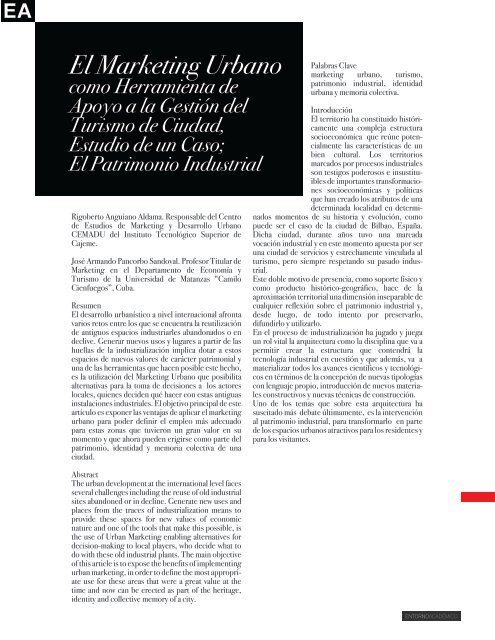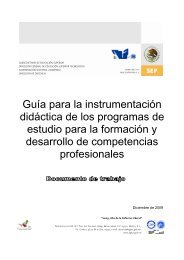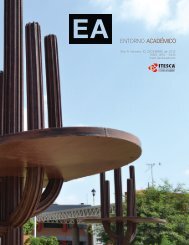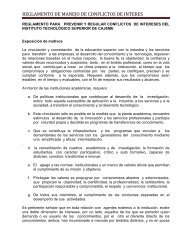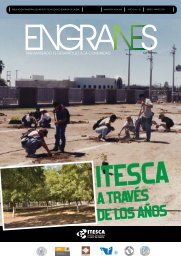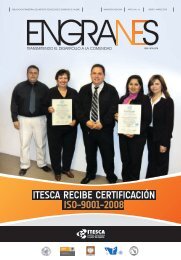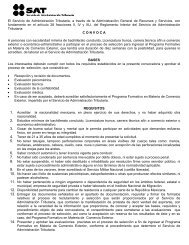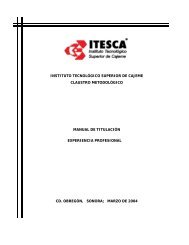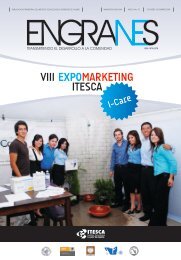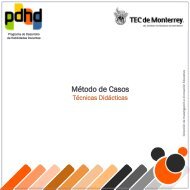Número 9 - Instituto Tecnológico Superior de Cajeme
Número 9 - Instituto Tecnológico Superior de Cajeme
Número 9 - Instituto Tecnológico Superior de Cajeme
You also want an ePaper? Increase the reach of your titles
YUMPU automatically turns print PDFs into web optimized ePapers that Google loves.
El Marketing Urbano<br />
como Herramienta <strong>de</strong><br />
Apoyo a la Gestión <strong>de</strong>l<br />
Turismo <strong>de</strong> Ciudad,<br />
Estudio <strong>de</strong> un Caso;<br />
El Patrimonio Industrial<br />
Rigoberto Anguiano Aldama. Responsable <strong>de</strong>l Centro<br />
<strong>de</strong> Estudios <strong>de</strong> Marketing y Desarrollo Urbano<br />
CEMADU <strong>de</strong>l <strong>Instituto</strong> <strong>Tecnológico</strong> <strong>Superior</strong> <strong>de</strong><br />
<strong>Cajeme</strong>.<br />
José Armando Pancorbo Sandoval. Profesor Titular <strong>de</strong><br />
Marketing en el Departamento <strong>de</strong> Economía y<br />
Turismo <strong>de</strong> la Universidad <strong>de</strong> Matanzas “Camilo<br />
Cienfuegos”, Cuba.<br />
Resumen<br />
El <strong>de</strong>sarrollo urbanístico a nivel internacional afronta<br />
varios retos entre los que se encuentra la reutilización<br />
<strong>de</strong> antiguos espacios industriarles abandonados o en<br />
<strong>de</strong>clive. Generar nuevos usos y lugares a partir <strong>de</strong> las<br />
huellas <strong>de</strong> la industrialización implica dotar a estos<br />
espacios <strong>de</strong> nuevos valores <strong>de</strong> carácter patrimonial y<br />
una <strong>de</strong> las herramientas que hacen posible este hecho,<br />
es la utilización <strong>de</strong>l Marketing Urbano que posibilita<br />
alternativas para la toma <strong>de</strong> <strong>de</strong>cisiones a los actores<br />
locales, quienes <strong>de</strong>ci<strong>de</strong>n qué hacer con estas antiguas<br />
instalaciones industriales. El objetivo principal <strong>de</strong> este<br />
artículo es exponer las ventajas <strong>de</strong> aplicar el marketing<br />
urbano para po<strong>de</strong>r <strong>de</strong>finir el empleo más a<strong>de</strong>cuado<br />
para estas zonas que tuvieron un gran valor en su<br />
momento y que ahora pue<strong>de</strong>n erigirse como parte <strong>de</strong>l<br />
patrimonio, i<strong>de</strong>ntidad y memoria colectiva <strong>de</strong> una<br />
ciudad.<br />
Abstract<br />
The urban <strong>de</strong>velopment at the international level faces<br />
several challenges including the reuse of old industrial<br />
sites abandoned or in <strong>de</strong>cline. Generate new uses and<br />
places from the traces of industrialization means to<br />
provi<strong>de</strong> these spaces for new values of economic<br />
nature and one of the tools that make this possible, is<br />
the use of Urban Marketing enabling alternatives for<br />
<strong>de</strong>cision-making to local players, who <strong>de</strong>ci<strong>de</strong> what to<br />
do with these old industrial plants. The main objective<br />
of this article is to expose the benefits of implementing<br />
urban marketing, in or<strong>de</strong>r to <strong>de</strong>fine the most appropriate<br />
use for these areas that were a great value at the<br />
time and now can be erected as part of the heritage,<br />
i<strong>de</strong>ntity and collective memory of a city.<br />
Palabras Clave<br />
marketing urbano, turismo,<br />
patrimonio industrial, i<strong>de</strong>ntidad<br />
urbana y memoria colectiva.<br />
Introducción<br />
El territorio ha constituido históricamente<br />
una compleja estructura<br />
socioeconómica que reúne potencialmente<br />
las características <strong>de</strong> un<br />
bien cultural. Los territorios<br />
marcados por procesos industriales<br />
son testigos po<strong>de</strong>rosos e insustituibles<br />
<strong>de</strong> importantes transformaciones<br />
socioeconómicas y políticas<br />
que han creado los atributos <strong>de</strong> una<br />
<strong>de</strong>terminada localidad en <strong>de</strong>terminados<br />
momentos <strong>de</strong> su historia y evolución, como<br />
pue<strong>de</strong> ser el caso <strong>de</strong> la ciudad <strong>de</strong> Bilbao, España.<br />
Dicha ciudad, durante años tuvo una marcada<br />
vocación industrial y en este momento apuesta por ser<br />
una ciudad <strong>de</strong> servicios y estrechamente vinculada al<br />
turismo, pero siempre respetando su pasado industrial.<br />
Este doble motivo <strong>de</strong> presencia, como soporte físico y<br />
como producto histórico-geográfico, hace <strong>de</strong> la<br />
aproximación territorial una dimensión inseparable <strong>de</strong><br />
cualquier reflexión sobre el patrimonio industrial y,<br />
<strong>de</strong>s<strong>de</strong> luego, <strong>de</strong> todo intento por preservarlo,<br />
difundirlo y utilizarlo.<br />
En el proceso <strong>de</strong> industrialización ha jugado y juega<br />
un rol vital la arquitectura como la disciplina que va a<br />
permitir crear la estructura que contendrá la<br />
tecnología industrial en cuestión y que a<strong>de</strong>más, va a<br />
materializar todos los avances científicos y tecnológicos<br />
en términos <strong>de</strong> la concepción <strong>de</strong> nuevas tipologías<br />
con lenguaje propio, introducción <strong>de</strong> nuevos materiales<br />
constructivos y nuevas técnicas <strong>de</strong> construcción.<br />
Uno <strong>de</strong> los temas que sobre esta arquitectura ha<br />
suscitado más <strong>de</strong>bate últimamente, es la intervención<br />
al patrimonio industrial, para transformarlo en parte<br />
<strong>de</strong> los espacios urbanos atractivos para los resi<strong>de</strong>ntes y<br />
para los visitantes.<br />
ENTORNOACADÉMICO


